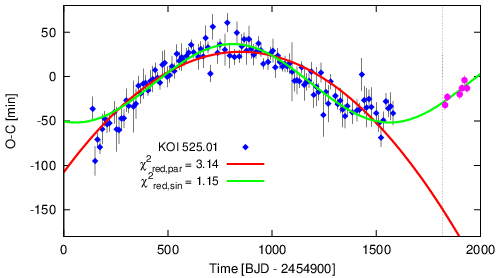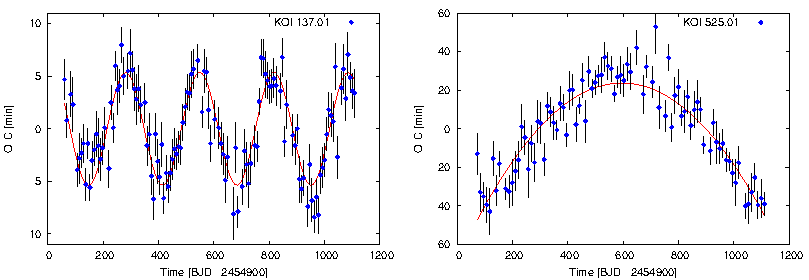 |
The basic aim of the network
Although there is no doubt that Kepler is the most successful planet-hunting telescope in history, due to malfunctions the continuous follow-up of the Kepler field came recently to an end. Therefore, the fate of many planetary systems that could not be confirmed and characterized via TTVs became uncertain. Since there are no confirmed forthcoming missions even comparable to Kepler space telescope in the near future, it is important to arrange ground-based observations now, with the main goal to continue with Kepler's heritage. In the framework of a large collaboration between several institutions around the globe, we are organizing a multisite photometric follow-up of Kepler KOIs. We will focus our instrumental capabilities into the KOIs that require additional data to achieve a proper characterization or confirmation by means of the TTV technique.

|
The figure above shows the O-C diagram of KOI-525.01 obtained with Kepler space telescope data (blue diamonds). In order to confirm the KOI as pplanetary in nature, a full revolution of the libration period is required. However, as in many other cases, this is no longer possible by means of space-based data. Our ground-based observations will be able to finish this work. They will start at the beginning of March (dashed vertical line) and will continue as long as the Kepler field of view is visible (end of November, 2014). Any additional point in an O-C diagram that looks parabolic can turn the parabola into a sinusoidal. Therefore, each and every primary transit light curve will be of great importance. Sinthetic ground-based data reproducing the photometric precision that a 2m telescope can achieve while observing a typical Kepler star reveals a photometric precision that will beat Kepler long cadence timing precision.
How can one validate, confirm, or characterize a KOI?
Generally, two fundamental issues can be addressed using
TTVs. To start, from primary transit fitting the planetary radius with
respect to the stellar radius can be measured with extreme precision
(Mandel & Agol 2002). However, the true value of the planetary radius
is uncertain due to a degeneracy between the radius and mass of the
host star (Seager & Mallen-Ornelas 2003). In such scenario, an
increase in the mass and radius of the star can yield an identical
light curve and period. However, if more than one planet is orbiting
the star, dynamical interactions between the planets will alter the
timing of the transits (see e.g., Dobrovolskis & Borucki 1996;
Miralda-Escude 2002). A measurement of these
timing variations, combined with radial velocity data, can break the
mass-radius degeneracy (Agol et al. 2005). Furthermore, single and
multiple planet candidate systems could harbor additional planets that
do not transit, with masses down to terrestrial ones. Such planets
might be detectable via TTVs (Agol et al. 2005; Holman & Murray 2005;
Holman et al. 2010) in a less-expensive way than by means of radial
velocity measurements. Therefore, TTV studies are of significant
relevance to better understand exoplanetary systems.
With respect to Kepler data, the first step towards the
characterization of a planetary system is its validation. To
this end, and in the absence of radial velocity measurements
that could confirm the mass of the transiting body as
planetary, the transit signal needs to be studied. If, for
example, there is a stellar binary system in the background or
the foreground of the Kepler target star (KTS) being under
study, the presence of the KTS could, in principle, dilute the
depth of the binary eclipse and make it appear
planetary. Therefore, a blend analysis needs to be carried out
(see Ballard et al. 2011, for a full description of the
validation process). After a system is validated, confirmation
and further characterization of planets can be produced by
means of TTV analysis (Holman et al. 2010; Lissauer et
al. 2011), radial-velocity variations (Borucki et al. 2010;
Koch et al. 2010; Dunham et al. 2010; Jenkins et al. 2010;
Latham et al. 2010), Spitzer observations (Desert et
al. 2011), and statistical analysis of false-positive
probabilities (see Cochran et al. 2007, for a paper with
complete confirmation processes in a multiple transiting
system). Once the false positive scenario is ruled out, TTVs
can be used to learn more about the KOIs. There are,
basically, three scenarios that deserve special attention:
- There is only one KOI transiting the star, and TTVs are
observed. Realistically, the orbital parameters of the perturber
cannot be uniquely determined, as various dynamical mechanisms can
match the TTV amplitude, period, and shape, and can also satisfy the
host star's radial velocity limits. However, upper limits on the
perturber's mass and orbital period can be determined, confirming its
planetary nature or overruling it.
- There are two (or more) KOIs transiting the star, and all
present TTVs. For pair of planets, anticorrelation in the TTV
signal is expected to occur. This observable is the product of
conservation of energy and angular momentum and is stronger
when the planetary pair is near mean motion resonance (it is
possible to have correlated TTV signals in systems far from
resonance or when one of the objects is precessing, but the
anticorrelation has short timescales Steffen et al. 2012a;
Fabrycky et al. 2012; Ford et al. 2012b). For mean motion
resonances, the TTVs show a clear sinusoidal variation (Agol
et al. (2005), see the following figure, left, as a
representative example). Only in this case the planetary
masses and orbital properties can be truly characterized.
- There are two (or more) KOIs transiting the
star. Anticorrelation occurs between pairs, but there is no complete
sinusoidal TTV signal (see the following figure, right, as a representative
example). In this case, further observations are required before the
planets can be confirmed. We must ensure that the TTVs have a
dynamical origin and that we are not, for instance, observing eclipse
timing variations in a multiple star system (Carter et al. 2011;
Slawson et al. 2011; Steffen et al. 2011) that has been diluted so the
eclipse depth is consistent with a planetary transit. Our network will
pay special attention to these systems. It is fundamental to
understand that any additional point in an O-C diagram that looks
parabolic can turn the parabola into a sinusoidal. This is necessary
and could be sufficient to confirm the KOI as planetary in
nature. Therefore, each and every primary transit light curve will be
of great importance.

|
What will we gain?
Only with the advent of Kepler data we were able to ask ourselves many fundamental questions about planetary systems: Is our Solar System unique? Where and how do planets form? Are current migration theories correct? Why are so many planetary systems close to mean motion resonances? Why is there are so few Jupiter-sized planets relative to the much more abundant Neptune-sized ones? The only way to shed some light onto these uncertainties is by analyzing the exoplanet population. Indeed, the characterization of planetary systems using the TTV method is of great importance to understand planet formation and evolution. Our network aims to help to answer these questions by increasing the number of confirmed and characterized exoplanets.